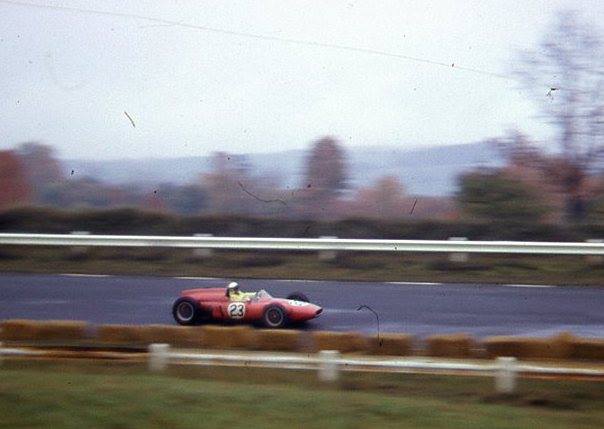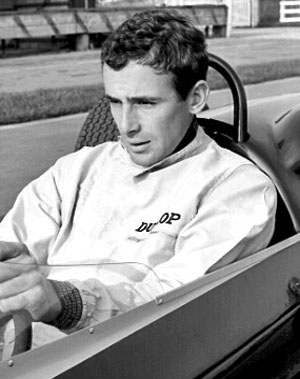Timothy Andrew Mayer (22 February 1938 – 28 February 1964) was a racecar driver from Dalton, Pennsylvania in the United States.
He participated in one World Championship Formula One Grand Prix, on October 7, 1962. He retired with ignition failure and scored no championship points. Info from Wiki
Bio by Stephen Latham
Timothy Andrew Mayer was born in Dalton, Pennsylvania, USA on the 22nd February 1938 and participated in one World Championship GP in 1962. His father was a stockbroker, as well as having a distinguished military service record, and an uncle, Will Scranton, was Pennsylvania state governor in the 1960s. His older brother Teddy had studied Law at Cornell University but he turned his back on the chance of a career to manage and further Tim’s progress to the top in motor racing. Together they went to Europe in the early 1960s and he went to become one of the founders of the McLaren team.
Tim began studying English Literature at Yale in 1956 and the following year met Garril, who would become his wife. In 1959 he started his final year at Yale, and also purchased an Austin-Healey, having a shared passion for fast cars with Teddy. Having acquired a racing licence when he turned 21 that year (the minimum age for a licence in America) he began racing in Sports Car Club of America events. He competed in five of thirteen national races that year, finishing seventh at Lime Rock (twice), eighth and fourth at Bridgehampton and was fourth in the national class standings. Recalling his first race he told how “it was wet and I was very much a newcomer to motor racing. I spun trying to change gears down a straight!” In December he was at the Annual international Bahamas Speed Weeks at Nassau with an Austin Healey 3000 and won one race and was ninth in the Nassau Memorial Trophy. He also married during the year and Garrill would accompany him on all his motor racing journeys.
For 1961 Tim obtained a Formula Junior Cooper but during this time, military service was required of him and he joined the US Army. After basic training in Fort Dix, New Jersey, he was later stationed in Puerto Rico, though was able to fit in races around his leave. He had three straight victories in a five race series to win the North Eastern States FJ Championship plus raced a Cooper Monaco sportscar which he acquired from Roger Penske.
In the following year, he was due to contest the Sebring 12 Hours in March with a Team Lotus Elite-Climax alongside Millar Ripley but they did not start. Tim teamed up with Peter Revson and Bill Smith to run under the Rev-Em Racing banner, with Teddy in charge and an old friend Tyler Alexander working on the cars. Tim proved the quickest of the three though as Teddy recalled “it drove Peter mad. But they got on well” and of the sixteen races contested, the team scored fifteen wins, fourteen second places and fourteen thirds. Tim took victories with the Cooper at Marlboro, Cumberland, Bridgehampton, Elkhart Lake and Meadowdale and was second (to Roger Penske’s Zerex Special though ahead of Dan Gurney and Hap Sharp) in the Puerto Rico GP at Antilles in November. His results saw him win the Sports Car Club of America FJunior Championship and they also awarded him the prestigious Kimberley Cup as ‘the most improved and outstanding American driver’. In October he stepped up to F1 when he competed in the US GP at Watkins Glen. The Cooper team brought two T60s for Bruce McLaren and Tony Maggs plus a T53, providing factory support for Tim, but though he was the fastest of the privateers in practice and qualified twelfth, he retired from the race on lap thirty one.
After completing his Army service, he was given a chance to drive for Ken Tyrrell’s team for 1963, with Teddy telling how Ken had invited Tim to “come over to Goodwood and show him what he could do, basically. We arrived in the middle of the biggest snowstorm I’d ever seen! It went from there very quickly.” Before these drives he contested US Road Racing events with a private Cooper Monaco T61-Climax and was sixth in the Daytona 200 and fourth at Pensacola. Tyrrell ran him in some European and British Championship rounds in a Cooper T67 but the BMC engine was down on power compared to the Fords used by Brabham, Lola and Lotus so he had very few chances to shine. The competition that year was also very strong, featuring drivers such as Frank Gardner, Mike Spence, Denny Hulme, Richard Attwood, David Hobbs and Peter Arundell. It gave him experience across Europe and England though and he told how “there is much more competition in Europe compared with the States. Formula Junior racing in Europe is like Russian roulette. The BMC engines were outdated and if we finished fourth or fifth we were doing well. The Cooper had little power but fantastic cornering-superior to the Lotus.” He was third and fourth at Roskilde and Clermont Ferrand and sixth and seventh at Reims and Rouen while in British rounds was sixth at Brands Hatch and fourth at Snetterton. He retired due to a crash in the British GP Junior race at Silverstone and crashed during the Tourist Trophy Junior at Goodwood after a brake caliper broke, and suffered a badly twisted neck. Teddy said Tim and Ken “got on like a house on fire. He immediately became a close friend and advisor.” In August, he was impressive in a Guards Trophy sports car race at Brands Hatch, for which he had flown his Cooper Monaco from America to compete, and finished third behind Roger Penske and Roy Salvadori. He also drove a factory Mini Cooper S in the last three rounds of the British Saloon Car Championship, finishing fifteenth (sixth in class) at Brands Hatch, thirteenth (third in class) at Oulton Park and eighth (second in class) at Snetterton. In October he led the 2-litre class with a Lotus 23B until heat forced his retirement at Riverside but the following week he won his class and finished sixth overall at Laguna Seca and in December took seventh and third in the Nassau Classic and Nassau Trophy.
Bruce McLaren paid tribute, telling how “we sat on top of the pits in the sun at Longford waiting for the first practice session to start: Timmy Mayer, his wife Garrill, the mechanics – our team..We were all happy. This was the last event of our tour. For two months we had worked, raced and relaxed together and, perhaps more than anyone else, Timmy was enjoying himself. He told me he really liked Australia. Intelligent and charming, he had made dozens of friends. As often occurs, to look at him you wouldn’t take him for a racing driver. You had to know him, to realise his desire to compete, to do things better than the next man, be it swimming, water-skiing or racing. So when, during the second practice session, he crashed at high speed and we knew immediately that it was bad, in our hearts we felt that he had been enjoying himself, and “having a go”. The news that he died instantly was a terrible shock to all of us. But who is to say that he had not seen more, done more and learned more in his 26 years than many people do in a lifetime? It is tragic, particularly for those left. Plans half made must now be forgotten, and the hopes must be rekindled. Without men like Tim, plans and hopes mean nothing. To do something well is so worthwhile that to die trying to do it better cannot be foolhardy. I can’t say these things well, but I know this is what I feel to be true. It would be a waste of life to do nothing with ones ability, life is measured in terms of achievement, not in years alone. To those who have shown Garrill, his wife, Teddy, his brother, indeed all of our team, so much kindness and consideration, I want to say “thank you.”
Teddy told how “he was very, very quick, no question. But maybe quick too soon, as he did have a few shunts. He was a natural athlete and went quickly because he just knew how to do it.” And Tyler Alexander stated “he was just a very personable, likeable guy. I think he was bloody good. It was still pretty early, but he was competing with guys with a lot more experience. He was getting better and better with every single race in that Tasman series.”
Teddy had a long think about his future in motorsport following Tim’s death but eventually continued as McLaren’s business manager and was joined by Tyler, who became one of the team’s chief mechanics and engineers. Following Bruce McLaren’s death in 1970, the pair ran McLaren’s F1, Can-Am and Indycar concerns until 1980, winning many major races and titles in all three categories, including the F1 World Championship with Emerson Fittipaldi in 1974 and James Hunt in 1976. McLaren also won the Indy 500 with Johnny Rutherford in 1974 and 1976; a McLaren chassis entered by Roger Penske also won the 500. Towards the end of the decade the team’s F1 results began to decline and title sponsor Marlboro engineered a merger with the Project 4 team run by Ron Dennis. Teddy remained as joint managing-director until 1982, when he sold his shares and left the team he had helped to create. He continued to work in motor sport, firstly in CART, running the Texaco Star team under the Mayer Motor Racing banner, then returned to F1 with Haas Lola. Shortly after the end of the 1986 season, Carl Haas was continuing to try to find funding to continue into 1987 but after being unable to find the sponsorship necessary, the team closed down. Following a year’s retirement, he then returned to CART racing, joining the Penske team as Vice-Chairman of Penske’s motorsports operations and presided over the teams’ success in the 1990s. He eventually moved to a consultancy role with them, which he continued until 2007 and died on the 30th January, 2009, of complications with Parkinson’s disease.






